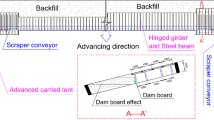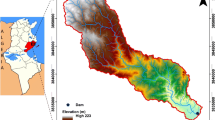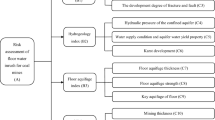Abstract
This paper describes a stepwise method for assessing lead hazards associated with mining. The procedural framework was constructed in a decision-tree format to facilitate a reliability estimate in the watershed. A sigmoid fuzzy membership function was proposed for measuring risks. Using the α-cut technique, seven areas of risk in the region were provided for all types of water use. The suggested model was validated at the Emarat lead mine, Iran. Samples were taken from the mine face, entrance tunnel, and drainage waters at the entrance and exit point of the processing plant and tailings dam. All of the samples were located in a very high risk zone (reliability = 0) for animal drinking water, but some could be used for crop irrigation (mine site’s samples reliability > 0.77 and processing plant’s samples reliability > 80).
Zusammenfassung
Dieser Artikel beschreibt eine schrittweise Methode für die Bewertung von Bleigefährdungen im Zusammenhang mit Bergbauaktivitäten. Die Vorgehensweise ist im Entscheidungsbaumformat konstruiert, um eine Zuverlässigkeitsabschätzung im Einzugsgebiet zu ermöglichen. Eine sigmoide Fuzzy-Membership-Funktion wurde vorgeschlagen, um das Risiko zu quantifizieren. Für alle Arten der Wassernutzung wurden in der Region sieben Risikobereiche mit Hilfe der α-Cut-Methode ausgewiesen. Am Emarat Bleierzbergwerk im Iran wurde das vorgeschlagene Modell validiert. Proben wurden am Stoß, im Zugangsstollen und am Zu- und Abflusspunkt der Aufbereitung und des Tailingsbeckens entnommen. Alle Proben zeigten ein sehr hohes Risiko für als Wasser für die Tiertränke (Zuverlässigkeit=0). Einige waren aber als Beregnungswasser nutzbar (Proben aus dem Bergwerksbereich Zuverlässigkeit >0,77 und aus dem Bereich der Aufbereitung Zuverlässigkeit >80).
Resumen
Este trabajo describe un método paso a paso para evaluar los riesgos asociados con plomo en minería. El marco de procedimientos se construyó en un formato de árbol de decisión para facilitar un cálculo de confiabilidad en la cuenca. Se propuso una función de membresía difusa sigmoidea para medir los riesgos. Utilizando la técnica de corte α, se proporcionaron siete áreas de riesgo en la región para todos los tipos de uso del agua. El modelo sugerido fue validado en la mina de plomo de Emarat, Irán. Se tomaron muestras de la superficie de la mina, el túnel de entrada y las aguas de drenaje en el punto de entrada y salida de la planta de procesamiento y la presa de relaves. Todas las muestras se ubicaron en una zona de riesgo muy alto (confiabilidad = 0) para el agua potable de animales, pero algunas podrían usarse para el riego de cultivos (confiabilidad de las muestras en el sitio de la mina> 0,77 y confiabilidad de las muestras de la planta de procesamiento> 80).
抽象
文章描述了一种逐步评价与采矿相关的铅危害的方法。评价框架基于决策树构建,以实现流域内可靠性评价。提出了一种度量风险的sigmoid模糊隶属函数。利用α-cut切割技术,选出区域内七个风险用水区。以伊朗艾玛特(Emarat)铅矿为例验证了该模型。一部分样品取自铅矿工作面和大巷入口,另一部排放废水取自污水处理厂和尾矿坝的入口和出口。所有样品都位于动物饮用水的高风险区(可靠性=0),但是有些仍可用于作物灌溉(采场样品可靠性>0.77,污水处理厂样品可靠性>80)。









Similar content being viewed by others
References
Amini M, Afyuni M, Khademi H, Abbaspour K, Schulin R (2005) Mapping risk of cadmium and lead contamination to human health in soils of central Iran. Sci Total Environ 347(1):67–77
Ayers RS, Westcot DW (1985) Water quality for agriculture. Food and Agriculture Org of the United Nations, Rome. http://www.fao.org/docrep/003/t0234e/t0234e00.HTM
Birolini A (2017) Reliability engineering: theory and practice. Springer, New York City
Cai KY (2012) Introduction to fuzzy reliability. Springer Science & Business Media, Boston
Cai KY, Wen CY, Zhang ML (1993) Fuzzy states as a basis for a theory of fuzzy reliability. Microelectron Reliab 33(15):2253–2263
Deb D, Deshpande VN, Das KC (2008) Assessment of water quality around surface coal mines using principal component analysis and fuzzy reasoning techniques. Mine Water Environ 27(3):183–193
Dubois DJ (1980) Fuzzy sets and systems: theory and applications, vol 144. Academic Press, Cambridge
Geological Survey of Iran (2017) Maps. http://www.gsi.ir/en/contents/our-products/0038/Maps.html. Accessed 28 Jan 2017
Gharibi H, Mahvi AH, Nabizadeh R, Arabalibeik H, Yunesian M, Sowlat MH (2012) A novel approach in water quality assessment based on fuzzy logic. J Environ Manag 112:87–95
Koczy LT (1996) Fuzzy if… then rule models and their transformation into one another. IEEE T Syst Man Cybern A 26(5):621–637
Li P, Wu J, Qian H, Lyu X, Liu H (2014) Origin and assessment of groundwater pollution and associated health risk: a case study in an industrial park, northwest China. Environ Geochem Health 36:693–712
Neira M, Kelley E, Bahl R, Chopra M, Wijesekera S (2015) Water, sanitation and hygiene in health care facilities—status in low- and middle-income countries and way forward. World Health Org, Geneva
Shiraishi N, Furuta H (1983) Reliability analysis based on fuzzy probability. J Eng Mech 109(6):1445–1459
Vadiati M, Asghari-Moghaddam A, Nakhaei M, Adamowski J, Akbarzadeh A (2016) A fuzzy-logic based decision-making approach for identification of groundwater quality based on groundwater quality indices. J Environ Manag 184:255–270
Zadeh LA (1978) Fuzzy sets as a basis for a theory & possibitity. Fuzzy Set Syst 1(1):3–28
Zimmermann HJ (2010) Fuzzy set theory. Comput Stat 2(3):317–332
Author information
Authors and Affiliations
Corresponding author
Electronic supplementary material
Below is the link to the electronic supplementary material.
Rights and permissions
About this article
Cite this article
Rezaei, Z., Ataee-pour, M. Assessment of Mine Water Environmental Impact: A Fuzzy Reliability Approach. Mine Water Environ 38, 30–38 (2019). https://doi.org/10.1007/s10230-018-00571-4
Received:
Accepted:
Published:
Issue Date:
DOI: https://doi.org/10.1007/s10230-018-00571-4




